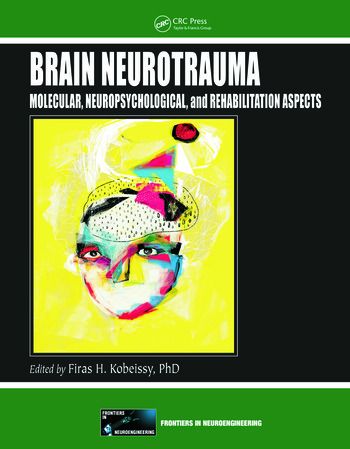(Frontiers in Neuroengineering Series)
Brain Neurotrauma, edited by Dr Firas H. Kobeissy is a comprehensive textbook of molecular aspects of brain trauma. There are over 119 contributing authors from numerous renowned international centres. The volume is well laid-out and has eight sections, divided into 49 chapters. These cover in extensive detail the basic science, the experimental models and the neurorehabilitative management of patients following brain injury. There is good discussion of the mechanics of brain injury, of experimental brain injuries and brain recovery models, biomarkers and also the after-effects of brain injury. The book also gives insight into various potential treatments and various treatment targets for the future, providing a much needed ray of hope for the reader.
The book is a comprehensive guide to current knowledge of pathophysiology, and the molecular and clinical aspects of brain injury. There is an effort, largely successful, to cover all the aspects of traumatic brain injury causative models, neuromechanics, imaging, biomarkers, neurocognitive and neurobehavioural aspects, and potential targets to enhance recovery following traumatic brain injury. The sections on the after-effects of mild brain injuries and sports injuries were very helpful additions. Neuro-rehabilitation and neuroprotection strategies such as non-invasive stimulation of brain or cranial nerves are especially interesting to me as a neuro-rehabilitation physician, and to my multidisciplinary team colleagues.
Clinicians will be enlightened to read about nanopeptides, roles for stem cells and the effects of comorbid conditions on recovery patterns following brain injury. In these cutting-edge topics, the comprehensive referencing is of course especially useful.
The clinician in search of enlightenment might have been helped along, however, if the authors had made more use of tables, colours and diagrams to illustrate the complex information. On the one hand, the book benefits from having so many contributors of high repute but, almost inevitably, their areas of expertise overlap and so too does the content of their chapters. For readers, wishing a quick read-through, this repetition would be a disadvantage. Conversely, the fact that each chapter is really an essay that can be read on its own will suit many.
The text focuses strongly on veteran injury and is geographically limited to practice in the United States. Much of the content is universal, of course, but some discussion of global issues would have been welcome.
Overall, this book represents a great addition to existing resources and is a good reference source for neuroscientists, neurorehabilitation physicians, neurologists and neurosurgeons with a special interest in traumatic brain injury.
ACNR 2015;16(2):33. Published online 14/6/16
